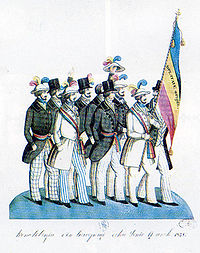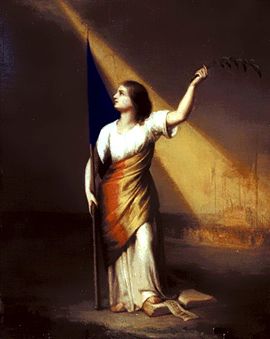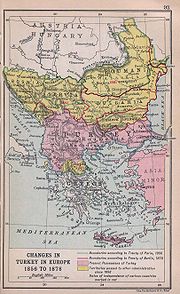
National awakening of Romania
Encyclopedia

Transylvania
Transylvania is a historical region in the central part of Romania. Bounded on the east and south by the Carpathian mountain range, historical Transylvania extended in the west to the Apuseni Mountains; however, the term sometimes encompasses not only Transylvania proper, but also the historical...
and Ottoman
Ottoman Empire
The Ottoman EmpireIt was usually referred to as the "Ottoman Empire", the "Turkish Empire", the "Ottoman Caliphate" or more commonly "Turkey" by its contemporaries...
suzerainty over Wallachia
Wallachia
Wallachia or Walachia is a historical and geographical region of Romania. It is situated north of the Danube and south of the Southern Carpathians...
and Moldavia
Moldavia
Moldavia is a geographic and historical region and former principality in Eastern Europe, corresponding to the territory between the Eastern Carpathians and the Dniester river...
, most Romanians
Romanians
The Romanians are an ethnic group native to Romania, who speak Romanian; they are the majority inhabitants of Romania....
were treated as second-class citizen
Second-class citizen
Second-class citizen is an informal term used to describe a person who is systematically discriminated against within a state or other political jurisdiction, despite their nominal status as a citizen or legal resident there...
s (or even non-citizens) in their country. In some Transylvanian cities, such as Braşov
Brasov
Brașov is a city in Romania and the capital of Brașov County.According to the last Romanian census, from 2002, there were 284,596 people living within the city of Brașov, making it the 8th most populated city in Romania....
(at that time the Transylvanian Saxon
Transylvanian Saxons
The Transylvanian Saxons are a people of German ethnicity who settled in Transylvania from the 12th century onwards.The colonization of Transylvania by Germans was begun by King Géza II of Hungary . For decades, the main task of the German settlers was to defend the southeastern border of the...
citadel of Kronstadt), Romanians were not even allowed to reside within the city walls.
The Romanians looked for support firstly from Russia, who they thought would help the Romanian Orthodox
Eastern Orthodox Church
The Orthodox Church, officially called the Orthodox Catholic Church and commonly referred to as the Eastern Orthodox Church, is the second largest Christian denomination in the world, with an estimated 300 million adherents mainly in the countries of Belarus, Bulgaria, Cyprus, Georgia, Greece,...
people in their struggle against the Islamic Ottoman empire. However, Russia's expansionist goals after annexing Bessarabia
Bessarabia
Bessarabia is a historical term for the geographic region in Eastern Europe bounded by the Dniester River on the east and the Prut River on the west....
in 1812, made them suspicious that they would just become part of another far-flung empire. Since Austria also had similar goals, as shown by the annexations of Oltenia
Oltenia
Oltenia is a historical province and geographical region of Romania, in western Wallachia. It is situated between the Danube, the Southern Carpathians and the Olt river ....
(1718–1739) and Bukovina
Bukovina
Bukovina is a historical region on the northern slopes of the northeastern Carpathian Mountains and the adjoining plains.-Name:The name Bukovina came into official use in 1775 with the region's annexation from the Principality of Moldavia to the possessions of the Habsburg Monarchy, which became...
(1775), the Romanians started looking for allies in Western Europe
Western Europe
Western Europe is a loose term for the collection of countries in the western most region of the European continents, though this definition is context-dependent and carries cultural and political connotations. One definition describes Western Europe as a geographic entity—the region lying in the...
.
In the Romantic era
Romanticism
Romanticism was an artistic, literary and intellectual movement that originated in the second half of the 18th century in Europe, and gained strength in reaction to the Industrial Revolution...
, the concept of a national state emerged among the Romanians, as among many other peoples of Europe and a national awakening
Romantic nationalism
Romantic nationalism is the form of nationalism in which the state derives its political legitimacy as an organic consequence of the unity of those it governs...
began. Defining themselves against the nearby Slavs, Germans
Volksdeutsche
Volksdeutsche - "German in terms of people/folk" -, defined ethnically, is a historical term from the 20th century. The words volk and volkische conveyed in Nazi thinking the meanings of "folk" and "race" while adding the sense of superior civilization and blood...
, and Hungarians, the nationalist Romanians looked for models of nationality in the other Latin countries, notably France
France
The French Republic , The French Republic , The French Republic , (commonly known as France , is a unitary semi-presidential republic in Western Europe with several overseas territories and islands located on other continents and in the Indian, Pacific, and Atlantic oceans. Metropolitan France...
.
Resistance movements

Tudor Vladimirescu
Tudor Vladimirescu was a Wallachian Romanian revolutionary hero, the leader of the Wallachian uprising of 1821 and of the Pandur militia. He is also known as Tudor din Vladimiri or — occasionally — as Domnul Tudor .-Background:Tudor was born in Vladimiri, Gorj County in a family of landed peasants...
's rebellion in 1821 was followed by the Revolutions of 1848
Revolutions of 1848
The European Revolutions of 1848, known in some countries as the Spring of Nations, Springtime of the Peoples or the Year of Revolution, were a series of political upheavals throughout Europe in 1848. It was the first Europe-wide collapse of traditional authority, but within a year reactionary...
in Moldavia, Wallachia, and Transylvania which sought complete independence for the first two and national emancipation in the third. These goals were unfulfilled, but were the basis of the subsequent revolutions.
The Great Powers did not support the Romanians' expressed desire to unite in a single state, forcing Romania to proceed alone against the Turks. The electors in both Moldavia and Wallachia chose the same person – Alexandru Ioan Cuza
Alexander John Cuza
Alexander John Cuza was a Moldavian-born Romanian politician who ruled as the first Domnitor of the United Principalities of Moldavia and Wallachia between 1859 and 1866.-Early life:...
– as prince (Domnitor
Domnitor
Domnitor was the official title of the ruler of the United Principalities of Wallachia and Moldavia between 1859 and 1866....
in Romanian
Romanian language
Romanian Romanian Romanian (or Daco-Romanian; obsolete spellings Rumanian, Roumanian; self-designation: română, limba română ("the Romanian language") or românește (lit. "in Romanian") is a Romance language spoken by around 24 to 28 million people, primarily in Romania and Moldova...
). Thus, Romania was created as a personal union, albeit a Romania that didn't include Transylvania, where Romanian nationalism inevitably ran up against Hungarian nationalism. For some time yet, Austria-Hungary, especially under the Dual Monarchy
History of Hungary
Hungary is a country in central Europe. Its history under this name dates to the early Middle Ages, when the Pannonian Basin was colonized by the Magyars, a semi-nomadic people from what is now central-northern Russia...
of 1867, would keep the Hungarians firmly in control, even in parts of Transylvania where Romanians constituted a local majority.
In 1861 the Transylvanian Association for the Literature and Culture of the Romanians (ASTRA) was founded in Sibiu
Sibiu
Sibiu is a city in Transylvania, Romania with a population of 154,548. Located some 282 km north-west of Bucharest, the city straddles the Cibin River, a tributary of the river Olt...
(then Hermannstadt), protected by an uncommonly enlightened local government composed largely of Transylvanian Saxons
Transylvanian Saxons
The Transylvanian Saxons are a people of German ethnicity who settled in Transylvania from the 12th century onwards.The colonization of Transylvania by Germans was begun by King Géza II of Hungary . For decades, the main task of the German settlers was to defend the southeastern border of the...
(Germans).
Background


Tudor Vladimirescu
Tudor Vladimirescu was a Wallachian Romanian revolutionary hero, the leader of the Wallachian uprising of 1821 and of the Pandur militia. He is also known as Tudor din Vladimiri or — occasionally — as Domnul Tudor .-Background:Tudor was born in Vladimiri, Gorj County in a family of landed peasants...
, for the emancipation of the lower classes, soon acquired, therefore, an anti-Greek tendency. Vladimirescu was executed by the Etaireía
Filiki Eteria
thumb|right|200px|The flag of the Filiki Eteria.Filiki Eteria or Society of Friends was a secret 19th century organization, whose purpose was to overthrow Ottoman rule over Greece and to establish an independent Greek state. Society members were mainly young Phanariot Greeks from Russia and local...
; the latter were completely checked by the Turks, who, grown suspicious after the Greek rising and confronted with the energetic attitude of the Romanian nobility, consented in 1822 to the nomination of two native boyars, Ioniţă Sandu Sturdza and Grigore IV Ghica
Grigore IV Ghica
Grigore IV Ghica or Grigore Dimitrie Ghica was Prince of Wallachia between 1822 and 1828. A member of the Ghica family, Grigore IV was the brother of Alexandru Ghica and the uncle of Dora d'Istria....
, recommended by their countrymen, as princes of Moldavia and Wallachia, respectively. The iniquitous system of 'the throne to the highest bidder' had come to an end.
The Phanariote regime in Wallachia and Moldavia ended after the uprising of 1821.
The 1829 Treaty of Adrianople
Treaty of Adrianople
The Peace Treaty of Adrianople concluded the Russo-Turkish War, 1828-1829 between Russia and the Ottoman Empire. It was signed on September 14, 1829 in Adrianople by Russia's Count Alexey Fyodorovich Orlov and by Turkey's Abdul Kadyr-bey...
(called also Treaty of Edirne), was settled between Russia and the Ottoman Empire. Turkey gave Russia access to the mouths of the Danube and additional territory on the Black Sea
Black Sea
The Black Sea is bounded by Europe, Anatolia and the Caucasus and is ultimately connected to the Atlantic Ocean via the Mediterranean and the Aegean seas and various straits. The Bosphorus strait connects it to the Sea of Marmara, and the strait of the Dardanelles connects that sea to the Aegean...
, opened the Dardanelles
Dardanelles
The Dardanelles , formerly known as the Hellespont, is a narrow strait in northwestern Turkey connecting the Aegean Sea to the Sea of Marmara. It is one of the Turkish Straits, along with its counterpart the Bosphorus. It is located at approximately...
to all commercial vessels, commerce is liberated for cereals, live stocks and wood, granted autonomy to Serbia, promised autonomy for Greece, and allowed Russia to occupy Moldavia and Walachia until Turkey had paid a large indemnity.
The Crimean War was provoked by Russian tsar Nicholas I
Nicholas I of Russia
Nicholas I , was the Emperor of Russia from 1825 until 1855, known as one of the most reactionary of the Russian monarchs. On the eve of his death, the Russian Empire reached its historical zenith spanning over 20 million square kilometers...
's continuing pressure on the dying Ottoman Empire, and by Russia's claims to be the protector of the Orthodox Christian subjects of the Ottoman sultan. Britain and France became involved in order to block Russian expansion and prevent Russians from acquiring control of the Turkish Straits and eastern Mediterranean.
Russia was defeated in the Crimean War
Crimean War
The Crimean War was a conflict fought between the Russian Empire and an alliance of the French Empire, the British Empire, the Ottoman Empire, and the Kingdom of Sardinia. The war was part of a long-running contest between the major European powers for influence over territories of the declining...
(1853–1856). The peace Congress in Paris
Treaty of Paris (1856)
The Treaty of Paris of 1856 settled the Crimean War between Russia and an alliance of the Ottoman Empire, the British Empire, Second French Empire, and the Kingdom of Sardinia. The treaty, signed on March 30, 1856 at the Congress of Paris, made the Black Sea neutral territory, closing it to all...
(February-March 1856) decided that Wallachia and Moldavia, which had been under Ottoman suzerainty, were now placed under the collective guarantee of the seven powers that signed the Paris peace treaty. These powers then declared that local assemblies be convened to decide on the future organisation of the two principalities. The Treaty of Paris also stipulated: the retrocession
Cession
The act of Cession, or to cede, is the assignment of property to another entity. In international law it commonly refers to land transferred by treaty...
to Moldavia of Southern Bessarabia, which had been annexed in 1812 by Russia (the Cahul, Bolgrad and Ismail counties); freedom of sailing on the Danube; the establishment of the European Commission of the Danube; the neutral status of the Black Sea.
As a result, Wallachia and Moldavia both elected Alexander John Cuza
Alexander John Cuza
Alexander John Cuza was a Moldavian-born Romanian politician who ruled as the first Domnitor of the United Principalities of Moldavia and Wallachia between 1859 and 1866.-Early life:...
in 1859 as their prince, creating a personal union. This personal union was turned into a state union, named Romania, which in 1866 adopted prince Carol
Carol I of Romania
Carol I , born Prince Karl of Hohenzollern-Sigmaringen was reigning prince and then King of Romania from 1866 to 1914. He was elected prince of Romania on 20 April 1866 following the overthrow of Alexandru Ioan Cuza by a palace coup...
from the Hohenzollern-Sigmaringen
Hohenzollern-Sigmaringen
-Noble jurisdictions:Prince Karl Eitel of Hohenzollern-Sigmaringen, and descendants of his nephew Ferdinand ruled over the Kingdom of Romania, as Karl Eitel did not have children...
family as its monarch.
Timeline
| • 1812 – | Russia annexes Bessarabia Bessarabia Governorate Bessarabia was an oblast and later a guberniya in the Russian Empire. It was the eastern part of the Principality of Moldavia annexed by Russia by the Treaty of Bucharest following the Russo-Turkish War, 1806-1812... . |
| • 1829 – | Treaty of Adrianople Treaty of Adrianople The Peace Treaty of Adrianople concluded the Russo-Turkish War, 1828-1829 between Russia and the Ottoman Empire. It was signed on September 14, 1829 in Adrianople by Russia's Count Alexey Fyodorovich Orlov and by Turkey's Abdul Kadyr-bey... : Russia declares protectorate over Moldavia and Wallachia. |
| • 1834 – | Russians withdraw from Moldavia and Wallachia. |
| • 1846 – | Customs union of Moldavia and Wallachia. |
| • 1848 – | Failed revolutions Revolutions of 1848 in the Habsburg areas From March 1848 through July 1849, the Habsburg Austrian Empire was threatened by revolutionary movements. Much of the revolutionary activity was of a nationalist character: the empire, ruled from Vienna, included Austrian Germans, Hungarians, Slovenes, Poles, Czechs, Slovaks, Ruthenians,... in the principalities and in Transylvania. |
| Russia reoccupies Moldavia and Wallachia. | |
| • 1856 – | Partial Russian withdrawal, following the Crimean War Crimean War The Crimean War was a conflict fought between the Russian Empire and an alliance of the French Empire, the British Empire, the Ottoman Empire, and the Kingdom of Sardinia. The war was part of a long-running contest between the major European powers for influence over territories of the declining... . |
| • 1859 – | Alexandru Ioan Cuza unites Moldavia and Wallachia United Principalities The United Principalities of Moldavia and Wallachia, also known as the Romanian Principalities, was the official name of Romania following the 1859 election of Alexandru Ioan Cuza as prince or domnitor of both territories... under his personal rule. |
| • 1861 – | ASTRA founded. |
| • 1862 – | Formal union of Moldavia and Wallachia to form principality of Romania. |
| • 1866 – | Karl von Hohenzollern-Sigmaringen becomes head of state, and will later be crowned as king. |
| • 1867 – | Formation of the Dual Monarchy of Austria-Hungary Austria-Hungary Austria-Hungary , more formally known as the Kingdoms and Lands Represented in the Imperial Council and the Lands of the Holy Hungarian Crown of Saint Stephen, was a constitutional monarchic union between the crowns of the Austrian Empire and the Kingdom of Hungary in... , which assigns Transylvania to Hungary. |
| • 1877 – | Russo-Turkish War and Romanian War of Independence Romanian War of Independence The Romanian War of Independence is the name used in Romanian historiography to refer to the 1877-1878 Russo-Turkish war, following which Romania, fighting on the Russian side, gained independence from the Ottoman Empire... |
| • 1881 – | Kingdom of Romania Kingdom of Romania The Kingdom of Romania was the Romanian state based on a form of parliamentary monarchy between 13 March 1881 and 30 December 1947, specified by the first three Constitutions of Romania... established |
| • 1918 – | Transylvania, part of Banat, Bessarabia and Bukovina are united with Romania Union of Transylvania with Romania Union of Transylvania with Romania was declared on by the assembly of the delegates of ethnic Romanians held in Alba Iulia.The national holiday of Romania, the Great Union Day occurring on December 1, commemorates this event... . |
External links
- National awakening of Romania at welcome2romania.ro
- Romania at my-world-guide.com
< Early Modern Times
Early Modern Romania
Early Modern Romania is the portion of Romanian history that falls in the early modern period, roughly from the end of the 15th century to the end of the 18th century...
| History of Romania | Kingdom of Romania
Kingdom of Romania
The Kingdom of Romania was the Romanian state based on a form of parliamentary monarchy between 13 March 1881 and 30 December 1947, specified by the first three Constitutions of Romania...
>

